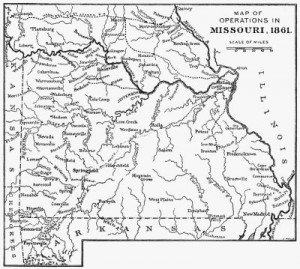Today Union raiders create havoc in Wright City, Missouri, a town in a border state evidencing mixed, vocal loyalties. Targeting buildings where Southern sympathizers are known to gather, the militia first strike the Baptist church, torching the meeting house. As the church blazes, the raiders move on to two local businesses, setting fire to a blacksmith shop and a saloon, both owned by Confederate supporters. Fortunately for locals, the torching is limited to these three buildings, as a nearby Union contingent arrives and persuades the raiders to cease their unauthorized offenses.
Many Baptist churches are burned during the course of the war, while others are turned into hospitals. While flames rise skyward in Wright City, Missouri, in the main war theater a reporter describes the Memphis, Tennessee, Baptist church building on Second Street that has been turned into a Union military hospital, and is now known as the “Gangrene Hospital.” While preaching is no longer taking place in the meeting house, the good of humanity is being served.
The popular idea of a hospital, especially a military hospital, is that of a sort of golgotha, a place of horrid sights, sounds and fetor. In common with others, our reporter admits that he had participated in this idea, so far at least as to look shudderingly upon a hospital as he passed, and to hurry forward with accelerated pace. It was not until recently that so unworthy an idea was removed from is mind, and that was done by visiting them and inspecting for himself their appearance and management. He selected the Gangrene Hospital under the charge of Dr. Cleveland, for his first essay, rightly judging that the worst aspects of a hospital would be visible in the treatment of a disease always accompanied with horrid symptoms and so frequently fatal. The building occupied for gangrene and erysipelas is the Baptist Church on Second street. It is admirably adapted for a hospital, especially one where much fresh air is needed. The body of the church forms the hospital wards embracing fifty beds arranged in four rows. The pulpit, with a little shelving, makes a good pharmacy, the retiring rooms of the parson form private offices for the surgeon in charge and for his cadets and assistants and the cottage in the rear, formerly the domicile of the sexton answers admirably for dining room, etc. One report met with the greatest courtesy, both from Dr. Cleveland, who is Surgeon in charge and Dr. Weeks, who had just been ordered to the post of Medical Director of the Department of Arkansas. The modesty of Dr. Cleveland was with difficulty overcome in getting his permission even to mention his name in this article. The Gangrene Hospital was opened July 29th, by Dr. Cleveland and order being dated the 19th of the previous month. The greatest number of patients in the wards at a single time has been twenty-five; at present there are eighteen, mostly convalescing and doing well. The cleanliness of the rooms, of the outhouses and appurtenances, was a matter of surprise until our reporter learned that there was a man kept all the time whitewashing where the antiseptic could be laid on with a brush, there it abounds, and no hall or corner from roof to foundations stone is left to harbor miasmatic exhalations. The beds are models of neatness, and when the difficulty of keeping them so under the frequent dressings necessary in gangrenous cases is considered, it is really wonderful to behold. If the hotel and boarding house-keepers could take lessons in this respect from Dr. Cleveland, the comfort of their guests would be greatly enhanced. A great fact in the science of healing has been developed in this hospital, viz.,: that bromine is a specific in the treatment of gangrene. The experiments which led to this discovery, we believe, by Dr. Hammond, Surgeon General of the United Sates, and followed up by Prof. Brainard, of Chicago. But these gentlemen confined its application to the bites of poisonous serpents, in which it was found almost a specific. Dr. Goldsmith, of Louisville, and Dr. Weeks, to whom we have already alluded in this article, extended its use to the poisonous matter of gangrene,and the following is the result: Of 29 cases treated without bromide, 9 died, all of gangrene. Of 146 cases treated with bromine, 12 have died, only for of them of gangrene. These results will startle the medical world, and if the experiment can be sustained, will prove bromine to be as great a specific in this disease as quinine is in intermittents.
The records of this hospital, made up daily monthly, are masterpieces of system and detail. Every indication is recorded and the results so thoroughly calculated as to afford permanent records for the medical profession of the highest value. Of the notes taken by our reporter, we may have occasion to make further use.
Sources: Walter Williams, editor, A History of Northeast Missouri, Vol. 1, pp. 673-674 (link); “The History of Wright City” (link); “Memphis Gangrene Hospital,” Memphis Bulletin, September 11, 1863 (link)



